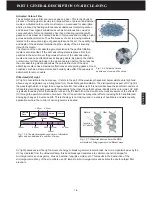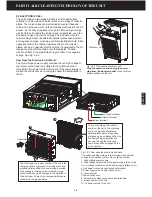
ENGLISH
PART I GENERAL DESCRIPTION ON AIR CLEANING
1-7
Fig. 1.2-9 How photo catalyst works.
Fig. 1.2-8 UV lamp and photo catalyst of 200T.
Photo catalyst
A photo catalyst is a chemical compound that becomes highly reactive when exposed to various wavelengths of UV light.
Photo catalytic oxidation is achieved when UV light rays is combined with a TiO
2
coated filter. TiO
2
refers to Titanium
Oxide. This process creates hydroxyl radicals and super-oxide ions, which are highly reactive electrons. These highly
reactive electrons aggressively combine with other elements in the air, such as bacteria and VOCs. Once they are
bounded together, the chemical reaction takes place between the super-charged ion and the pollutant, effectively
"oxidizing" (or burning) the pollutant. This breaks the pollutant down into harmless carbon dioxide and water molecules,
making the air more purified.
Photo catalytic oxidation
The key to PCO is the photo catalyst. Titanium dioxide (TiO
2
) is a
semiconductor photo catalyst with the band gap energy of 3.2eV.
When this material is irradiated with photons of less than 385 nm, the
band gap energy is exceeded and an electron is promoted from the
valence band to the conduction band. The resultant electron-hole pair
has a lifetime in the space-charge region that enables its participation
in chemical reactions. The most widely postulated reactions are shown
as Fig. 1.2-10 below
.
Hydroxyl radicals and super-oxide ions are highly reactive species that
will oxidize volatile organic compounds (VOCs) adsorbed on the
catalyst surface. They will also kill and decompose adsorbed bio-
aerosols. The process is referred to as heterogeneous photo catalysis
or, more specifically, photo catalytic oxidation (PCO). Several
attributes of PCO make it a strong candidate for indoor air quality
(IAQ) applications. Pollutants, particularly VOCs, are preferentially
adsorbed on the surface and oxidized to (primarily) carbon dioxide
(CO
2
). Thus, rather than simply changing the phase and concentrating
the contaminant, the absolute toxicity of the treated air stream is
reduced, allowing the photo catalytic reactor to operate as a self-
cleaning filter relative to organic material on the catalyst surface.
Photocatalyst
UV lamp
VOC is an acronym for Volatile
Organic Compounds. VOCs are
organic chemicals that contain the
carbon element. They are carbon
compounds that easily evaporate at
room temperature and often have a
sharp smell. They can come from
many products, such as office
equipment, adhesives, carpeting,
upholstery, paints, solvents and
cleaning products. Some VOCs can
cause cancer in certain situations,
especially when they are
concentrated indoors. VOCs also
create ozone, a harmful outdoor air
pollutant.
UV light
OH
-
.OH
(Hydoxyl radicals)
+
+
+
+
+
e
TiO2
TiO
2
+ UV = h+ + e-
.O
2
(Super-oxide inos)
O
2
Содержание R200T
Страница 69: ...ENGLISH NOTES ...










































